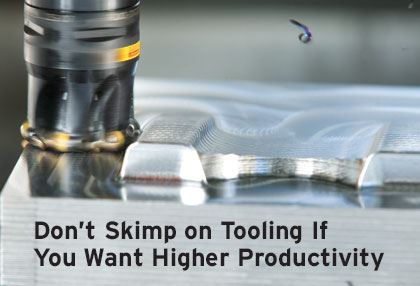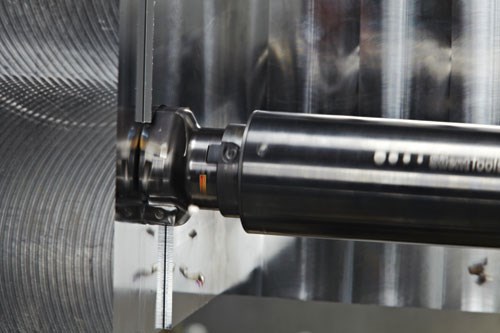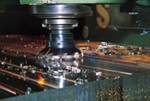Don’t Skimp on Tooling If You Want Higher Productivity
To enhance production and your return on investment, choose your tooling based on innovation and productivity.
As economic conditions improve and global competition intensifies, mold manufacturers are flocking to cutting-edge machine technology to achieve maximum efficiency. However, while new machine technologies dominate popular interest, tooling sometimes remains on the backburner.
Choosing tooling based on innovation and productivity can greatly enhance production and ultimately lead to a greater return on investment. Whether purchasing a new machine or optimizing an existing one, an integrated tooling strategy can go far beyond higher metal-removal rates, better part quality and decreased cycle times. Premium tooling technology can also significantly improve machine utilization, cut unnecessary expenses, decrease cost per part and even boost the return on a machine investment. While upgraded tooling increases the initial investment, the long-term benefits and cost savings make it lucrative.
Companies looking to improve productivity by employing the latest tooling technologies would benefit from involving experienced partners, right from the start. Working together with a partner on process optimization can improve machining solutions, optimize efficiency and bring the greatest return on investment to a moldmaking operation.
Tools for Successful Productivity
In addition to being highly beneficial to a company’s bottom line, integrating premium tooling and toolholding systems is considerably easier than purchasing new machines and optimizing other processes—and there’s certainly no shortage of innovative tooling solutions from which to choose.
Anti-Vibration Tooling
A tooling innovation that can significantly improve productivity is dampened tooling. These tools employ a special dampening mechanism to counteract vibration common during the use of long, slender tooling. These tools not only provide better surface finish, but also allow machinists to increase spindle speed and feedrate, cutting cycle time in half without sacrificing quality. Investing in benefits like this can have tremendous effects not just on productivity, but on overall profitability in the long run.
Anti-vibration tooling is normally used as a problem-solver in extreme applications like the machining of deep holes and cavities. However, moldmakers are discovering new uses for dampened products that can dramatically reduce their cycle time and increase productivity. For example, in a 5 X D milling setup, a dampened facemill adapter allows double or triple the cutting depths, compared to the original setup. Flexibility like that can offer a great competitive advantage.
In addition, dampened products can help machinists streamline machining processes by using a single tool for both roughing and finishing operations. Thanks to the flawless surface quality they produce, a job that might have employed two or three separate boring bars to achieve the necessary tolerances might only need one with a dampened system.
Premium Threading Tools
When a moldmaking operation represents a huge investment in time, money and know-how it is easy to understand why mold manufacturer demand high precision and more consistent machining. Using high-performance tapping tools that are optimized for each ISO material can yield a highly productive and efficient machining process. Compared to the alternative, these dedicated taps include a special edge design that is adapted for each tap size and application, ensuring reduced axial forces and torque. This makes the tool run smoothly, reducing the risk for chipping and improving the surface quality of the thread.
Modular Tooling Systems
Quick-change tooling is another beneficial investment. Shops should opt for a modular, universal quick-change system for higher flexibility to help reduce their tool inventory. Switching to a quick-change system can result in as much as a 25-percent increase in cutting time. By decreasing setup time and idle machine time, shops can produce a larger variety of components.
Specialized Grades
Last, but not least, choosing a specialized milling grade designed to perform on hardened steels can significantly improve process security, extend tool life, increase speed and feedrate, and cut time associated with tool changes. What’s more, mold manufacturers can streamline their tooling to reduce costs by using one, optimized grade type that will work across multiple roughing and finishing applications.
The Right Tools, Right from the Start
While better tooling can boost a company’s competitive advantage, the timing and planning behind it are vital. And while mold manufacturers can optimize tooling at any time, an ideal opportunity to assess tooling is at the beginning of a new job or new part production.
By thinking strategically about tooling and consulting with the right partners, shops can avoid the trial-and-error of finding the right tooling for the job. This upfront planning will not only ensure a smoother run-off and minimum production disruption, but can also help reduce cost-per-component and make subsequent jobs much more profitable.
Finding hands-on partners is key to this process, because they can call attention to tooling options and cutting processes that mold manufacturers may not have used traditionally. With parts becoming more complex, tolerances stricter and competition fiercer, this kind of proactive investment in advanced technology is no longer a luxury, but a requirement to remain competitive.
The speed in which companies use and drive technology forward, together with their partners, will determine their place in the global market; ultimately bringing them the highest and quickest return on investment.
Related Content
6 Ways to Optimize High-Feed Milling
High-feed milling can significantly outweigh potential reliability challenges. Consider these six strategies in order to make high-feed milling successful for your business.
Read MoreHow to Optimize Mold Finishing
Circle segment technology requires fewer tool paths, improving surface quality and increasing cutting tool life.
Read MoreHow to Overcome Cutting Tool Vibration
Advanced indexable milling cutting tool design provides secure, predictable machining, increased metal removal rates, reduced cycle times and fast changeovers.
Read MorePrecision Meets Innovation at IMTS 2024
After attending IMTS, it's clear that the integration of advanced technologies is ready to enhance precision, efficiency and automation in mold manufacturing processes. It’s a massive event, so here’s a glimpse of what the MMT team experienced firsthand.
Read MoreRead Next
Milling Advances Increase Productivity
Keeping on top of new advances in cutting tools can keep moldmakers profitable.
Read MoreOvercoming Pain Points in Moldmaking with AI
Shops that embrace AI as a tool, not a threat, can enhance efficiency, preserve expertise, and attract tech-savvy talent.
Read MoreHow to Use Continuing Education to Remain Competitive in Moldmaking
Continued training helps moldmakers make tooling decisions and properly use the latest cutting tool to efficiently machine high-quality molds.
Read More
























